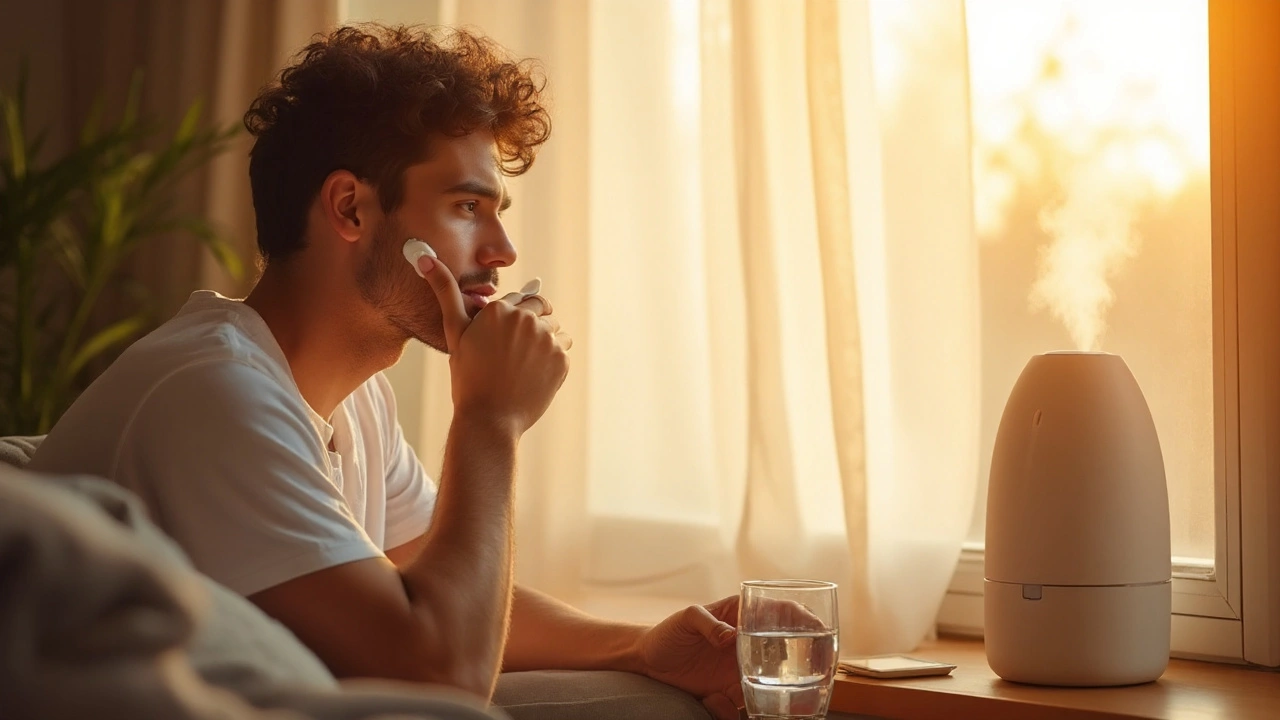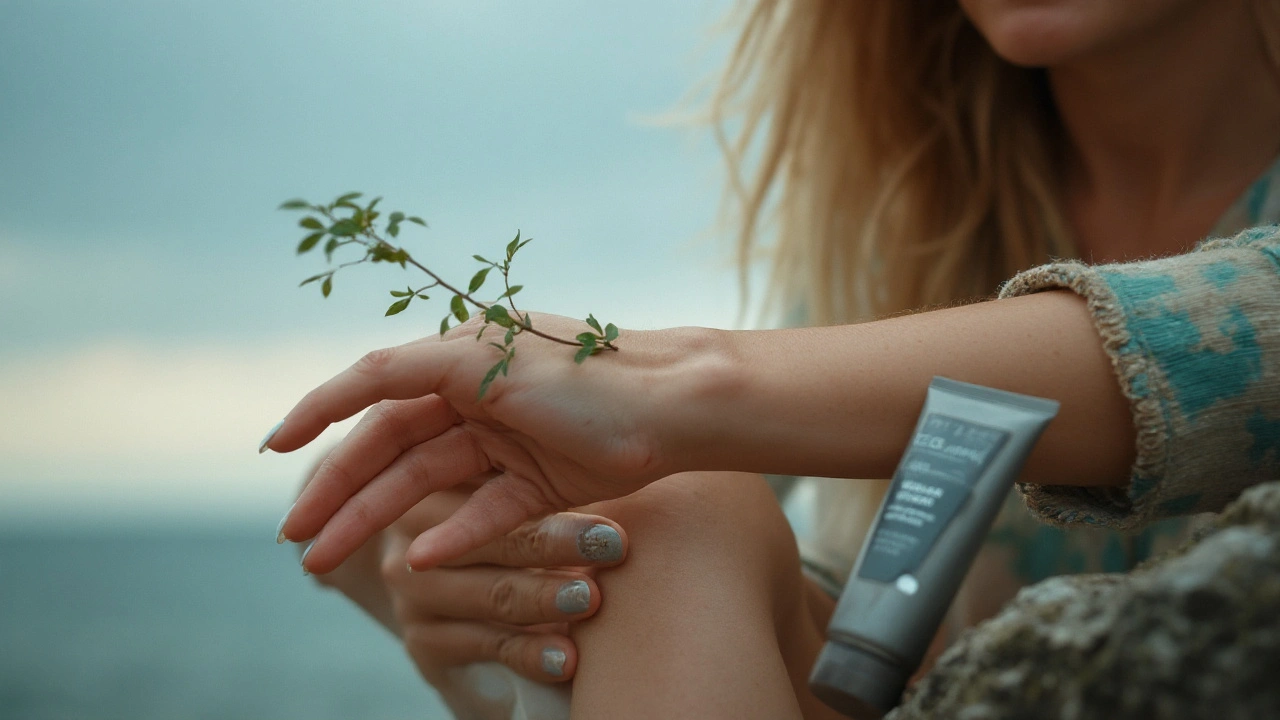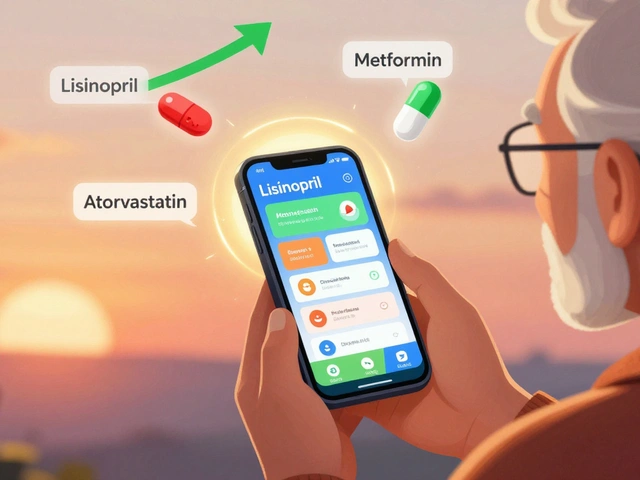Skin‑Weather Comfort Checker
TL;DR
- Cold, wind, and low humidity→dry skin and nerve irritation.
- Heat, UV, and humidity→heat rash, itching, and inflammation.
- Hydrate inside and out, use a barrier‑protecting moisturizer, and regulate indoor climate.
- Know when to call a dermatologist for chronic conditions like eczema or psoriasis.
- Simple tools-humidifier, protective clothing, and sunscreen-make a big difference.
Skin pain is a discomfort or ache that originates in the epidermis or dermis, often intensified by external stressors such as temperature swings, wind, or UV radiation. While most people think of pain as a sign of injury, the skin can react to subtle climate shifts without a visible wound. Understanding the link between weather changes and skin pain is the first step toward relief.
Why Weather Triggers Skin Pain
Weather isn’t just a backdrop; it actively reshapes the skin’s barrier. When humidity drops below 30%, the outermost layer-the stratum corneum-loses water, becoming flaky and less elastic. This loss exposes nerve endings, turning a mild itch into a sharp sting.
Conversely, high heat and humidity raise skin temperature, widening blood vessels and prompting sweat glands to work overtime. Excess sweat can trap salts on the surface, irritating the skin and provoking a burning sensation.
UV radiation, especially in summer, damages skin proteins (collagen and elastin) and triggers inflammation. Even on cloudy days, up to 80% of UV‑B reaches the surface, aggravating conditions like rosacea and causing a lingering ache.
Common Weather‑Related Skin Conditions
Below are the most frequent culprits that turn a breezy day into a painful one.
- Dry skin (xerosis): Tight, scaling, and prone to fissures; worst in winter’s low humidity.
- Atopic dermatitis: Chronic eczema flares when moisture evaporates or when wind strips the skin’s protective lipids.
- Psoriasis: Plaques can crack and bleed in dry air; heat can trigger “Koebner” lesions where pressure occurs.
- Heat rash (miliaria): Small red bumps that itch or burn when sweat ducts get blocked in hot, humid climates.
- Cold urticaria: Rapid hives and burning after cold exposure, common for those with sensitive mast cells.
Everyday Strategies to Shield Your Skin
Protecting skin pain isn’t about a single product; it’s a bundle of habits that together reinforce the barrier.
1. Hydrate From Within
Drink at least 2liters of water daily. Studies from the Australian National Health and Medical Research Council show a 20% reduction in perceived skin dryness when fluid intake meets the recommended level.
2. Choose the Right Moisturizer
Look for products that combine three functional groups:
- Occlusives (e.g., petrolatum, dimethicone) to lock in moisture.
- Emollients (e.g., shea butter, ceramides) to smooth the surface.
- Humectants (e.g., glycerin, hyaluronic acid) that draw water into the stratum corneum.
Apply within three minutes of showering while skin is still damp; this seals the moisture.
3. Barrier‑Boosting Creams
When the environment is extreme-sub‑10°C wind or >35°C heat-swap regular moisturizers for a barrier cream that contains high concentrations of ceramides and niacinamide. These ingredients reinforce lipid layers and reduce transepidermal water loss (TEWL) by up to 40%.
4. Regulate Indoor Climate
In winter, a humidifier set to 40‑50% humidity stops skin from drying out. In summer, a dehumidifier or air‑conditioning helps curb excess sweat and prevents heat rash.
5. Shield From Wind and UV
Wear breathable, tightly‑woven fabrics-like soft‑shell jackets-that block wind without trapping heat. For UV, choose a broad‑spectrum sunscreen with SPF30 or higher, reapplying every two hours outdoors.
6. Use Soothing Topicals When Needed
If itching spikes, a thin layer of hydrocortisone 1% cream can calm inflammation for up to a week. For chronic eczema, a prescription‑strength steroid or a calcineurin inhibitor may be required-consult a dermatologist.

Product Comparison: Moisturizers vs. Barrier Creams vs. Humectants
| Product Type | Main Ingredient | Best Climate | Typical Price (AUD) |
|---|---|---|---|
| Moisturizer | Glycerin + Shea Butter | Moderate (20‑30% humidity) | 15‑30 |
| Barrier Cream | Ceramides + Niacinamide | Cold, windy, or very dry | 25‑45 |
| Humectant Serum | Hyaluronic Acid (1‑2%) | Humid or post‑shower | 20‑35 |
Related Concepts and How They Interact
Understanding the broader skin ecosystem helps you fine‑tune your routine.
- Skin barrier function: The lipid matrix that prevents water loss; compromised by low humidity or harsh soaps.
- Inflammatory mediators (histamine, cytokines): Released when the barrier is breached, causing pain and itch.
- Mast cells: Play a role in cold urticaria; stabilizers like cromolyn can be prescribed.
- Microbiome: A balanced skin flora reduces flare‑ups; over‑cleansing strips beneficial bacteria.
Troubleshooting Common Scenarios
Scenario A - Persistent itch after a cold front
- Check indoor humidity; raise it to 45% with a humidifier.
- Switch to a ceramide‑rich barrier cream applied twice daily.
- Consider a short course of oral antihistamine if itching interferes with sleep.
Scenario B - Burning sensation during a heatwave
- Stay in air‑conditioned rooms; keep temperature under 24°C.
- Use a lightweight, non‑comedogenic moisturizer with hyaluronic acid.
- Apply a zinc‑oxide based sunscreen to reduce UV‑induced inflammation.
Scenario C - Flare‑up of eczema after wind exposure
- Wear wind‑protective clothing (soft‑shells, long sleeves).
- Immediately re‑apply a barrier cream to re‑seal the lipid layer.
- Schedule a visit with a dermatologist for possible prescription therapy.
Next Steps: Building a Personal Weather‑Skin Action Plan
Take a few minutes each week to log the following:
- Daily indoor humidity (use a hygrometer).
- Skin comfort rating (1‑10) after morning shower.
- Products used and any reactions.
After a month, patterns emerge-perhaps you notice a dip in comfort when humidity falls below 35%. Armed with this data, you can pre‑emptively ramp up barrier cream use or adjust your thermostat.
Frequently Asked Questions
Why does my skin feel more painful on windy days?
Wind accelerates evaporation of the skin’s surface water, thinning the stratum corneum and exposing nerve endings. The result is a tight, burning sensation that feels like pain.
Can a humidifier really stop winter skin pain?
Yes. Raising indoor humidity to 40‑50% reduces transepidermal water loss by up to 40%, which softens the skin and eases the sting that comes from dry, cracked surfaces.
Is sunscreen necessary on cloudy days?
Absolutely. Up to 80% of UV‑B rays penetrate clouds. Without broad‑spectrum SPF30, UV‑induced inflammation can still provoke skin pain, especially for sensitive conditions like rosacea.
What’s the difference between a moisturizer and a barrier cream?
Moisturizers focus on adding and retaining water using humectants and emollients. Barrier creams prioritize occlusive ingredients (petrolatum, ceramides) that seal the skin against external aggressors. In extreme weather, a barrier cream offers stronger protection against TEWL.
When should I see a dermatologist for skin pain?
If pain persists more than two weeks despite proper moisturization, or if you notice cracks, bleeding, or spreading rash, schedule an appointment. Chronic conditions like eczema, psoriasis, or unexplained neuropathic pain need professional evaluation.







Shivani Tipnis
September 24, 2025 AT 08:14This is the kind of practical advice I wish doctors actually gave. Hydrate inside and out? Duh. But nobody tells you *how* to do it right. Barrier creams with ceramides? Game changer. I used to ruin my skin with fancy serums. Now I just slap on petrolatum after showers. Done.
Denise Wood
September 25, 2025 AT 11:39Just wanted to add: if you're using hyaluronic acid in dry climates, you're actually making things worse unless you seal it with an occlusive. HA pulls water from the air-but if the air's dry, it pulls from your skin. So always layer it under a cream. Learned this the hard way after 3 months of stinging.
Katie Wilson
September 25, 2025 AT 18:28I swear my skin has a personality. When the barometric pressure drops? It screams. No joke. I get this deep, throbbing ache like my face is wrapped in sandpaper. Nobody believes me until they live through a Colorado winter. Then they get it. And yes, I use ceramide cream. And yes, I cry. But I'm alive.
Amy Reynal
September 27, 2025 AT 12:14Let’s be real-this whole ‘skin pain’ thing is just capitalism repackaging natural bodily reactions as ‘problems’ you can buy your way out of. But also… I use the barrier cream. And the humidifier. And the SPF30 even when it’s raining. Because I don’t want to be that person who looks like a lizard in March. So yeah. I’m a hypocrite. But a well-moisturized one.
Andrew Butler
September 27, 2025 AT 17:24UV-B penetrates clouds? Bro. That’s not even science. That’s a marketing lie from sunscreen companies. I’ve been outside for 12 hours on overcast days and my skin’s fine. You’re all just scared of the sun because your parents told you it’s evil. Also, typo in ‘2liters’-it’s 2 liters. Fix your article.
Erick Horn
September 28, 2025 AT 17:59Funny how we treat skin like a fragile flower. It’s been evolving for 200 million years. You think a humidifier is gonna fix what nature designed to handle? Nah. You’re just lazy. Go outside. Get a tan. Stop coddling your epidermis.
Chris Bock
September 30, 2025 AT 14:14The skin isn't a barrier. It's a conversation. Between you and the world. When it hurts, it's not failing. It's speaking. You just don't want to listen. Maybe the pain isn't the problem. Maybe the solution is surrender.
Cindy Fitrasari S.
October 1, 2025 AT 20:45I tried everything. Serums. Oils. Expensive creams. Then I just started wearing a cotton scarf in winter. Not for fashion. For function. It blocked the wind. No more burning. I feel like an idiot for not trying this sooner. Also, I don’t own a humidifier. And I’m fine.
Priyamvada Toshniwal
October 2, 2025 AT 06:21For anyone in India dealing with monsoon skin issues: the real villain isn't humidity-it's the soap you're using. Switch to a no-foam, sulfate-free cleanser. And skip the toner. Your skin doesn't need to be squeaky clean. It needs to be calm. Trust me, I'm a nurse. Been seeing this for 12 years.
Lee Lach
October 2, 2025 AT 07:13This entire post is a symptom of late-stage consumerist delusion. You’ve been conditioned to believe your skin is a product to be optimized. But what if the pain is a signal? A biological protest against pollution, processed food, and 12-hour screen exposure? You’re treating the symptom while ignoring the systemic rot. Also, your table has inconsistent decimal formatting in the price column. This is why science is dying.
Alyson Knisel
October 3, 2025 AT 01:30I used to think skin pain was just me being dramatic. Turns out, it’s just my body saying ‘hey, you’re not hydrating enough and you’re using dish soap as face wash.’ I feel seen. And also a little guilty. But also… I’m gonna try the ceramide thing. Maybe.
Varun Gupta
October 3, 2025 AT 05:06They don’t want you to know this but… all skin pain is caused by 5G towers and fluoride in the water. The ‘barrier cream’? Just a distraction. They’re selling you lotion so you forget the real enemy: the government’s weather control program. I’ve seen the documents. Look up Project SkyMist. Your skin is a pawn.
Jelisa Cameron- Humphrey
October 4, 2025 AT 12:06For those of you using jargon like ‘transepidermal water loss’-yes, it’s real. But also, if you’re explaining TEWL to someone who just wants to stop their face from burning, you’re missing the point. Use simple words. ‘Your skin’s leaking water.’ That’s all they need to hear. And then hand them the cream. No lectures.